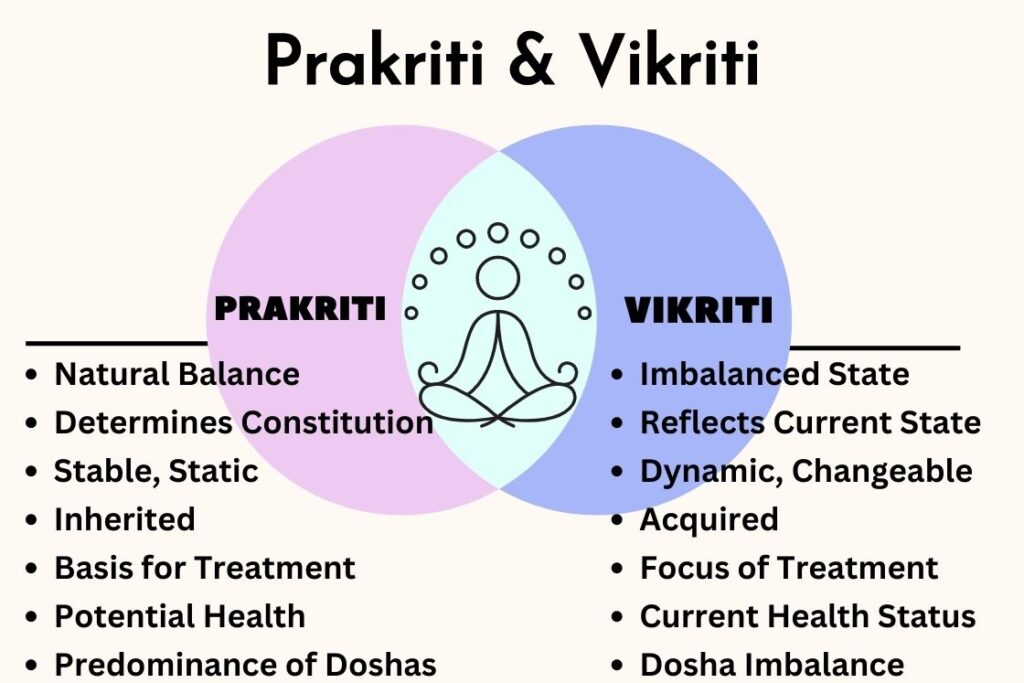
Prakriti and Vikriti are fundamental concepts in Ayurveda that help understand an individual’s inherent constitutional body type and their current state of health. These concepts are used to promote balance and wellness through personalized approaches to diet, lifestyle, and treatment.
In simple terms, Prakriti refers to the natural constitution we are born with, while Vikriti represents our current health condition
Both Prakriti and Vikriti are based on the three doshas: Vata, Pitta, and Kapha, which form the body’s constitution. Each person is a unique combination of one, two, or all three doshas.
This article delves deeper into the concepts of Prakriti and Vikriti, explaining their significance and applications in Ayurveda.
In this article, we have explained the concepts of Prakriti and Vikriti in detail.
Understanding Prakriti

The word Prakriti is derived from three components: the prefix ‘Pra,’ meaning “origin”; ‘Kri,’ meaning “to do”; and ‘Ti,’ meaning “to intensify.” Together, Prakriti refers to the entity that manifests at the time of origin.
Prakriti represents the original body constitution or the inherent combination of doshas that a person develops at the time of conception.
It is the nature you are born with and is unique to you. Each person’s constitution is predetermined at birth and influenced by various traits, including appearance, personality, habits, and dietary preferences. Prakriti determines a person’s physical and mental characteristics and remains constant throughout their life.
According to Ayurveda, this happens because a person’s Prakriti is determined at birth by the panch mahabhutas (air, fire, water, ether, and earth), doshas (vata, pitta, kapha), and trigunas (sattva, rajas, and tamas).
Doshaja Prakriti

At the time of conception, the predominance of one, two, or all three doshas determines an individual’s Prakriti, known as Doshaja Prakriti.
Doshaja Prakriti is further classified into three categories: Eka Doshaja Prakriti, Dwandvaja Doshaja Prakriti, and Sama Doshaja Prakriti.
- Eka Doshaja Prakruti – As the name suggests, individuals with a predominance of one (eka) dosha have an Eka Doshaja Prakriti. This type is relatively rare. Among these:
- Vata body type is considered inferior (heena).
- Pitta body type is considered moderate (madhyama).
- Kapha body type is regarded as superior (uttama).
- Dwandvaja Doshaja Prakruti – This is the most common type of Prakriti, where an individual has a combination of two doshas. There are three variations:
- Vata/Pitta (or pitta/vata) – Vata primary and Pitta secondary (or Pitta primary and Vata secondary).
- Pitta/Kapha (or kapha/pitta) – Pitta primary and Kapha secondary (or Kapha primary and Pitta secondary).
- Kapha/Vata (or vata/kapha) – Kapha primary and Vata secondary (or Vata primary and Kapha secondary).
- Sama Doshaja Prakruti – Among the rarest Prakriti types, individuals with a Sama Doshaja Prakriti have a balanced combination of all three doshas. This is considered the highest (sreshta) body constitution. However, it is challenging to maintain due to modern unhealthy lifestyles and dietary habits.
Manasika Prakriti
Manasika Prakriti refers to an individual’s psychological or mental constitution, which is determined by the combination of the three Gunas Sattva, Rajas, and Tamas. As a result, a person’s Manasika Prakriti can be classified as Satvik, Rajasik, or Tamasik.
Understanding Manasika Prakriti is crucial for choosing the right methods to support mental and emotional well-being, such as yoga, meditation, or tailored dietary and lifestyle practices.
Similarly, knowing a person’s Doshaja Prakriti helps an Ayurvedic practitioner understand their personality, temperament, characteristics, and overall health, enabling them to recommend appropriate treatments and interventions.
What factors determine the Prakriti of an individual?
The formation of Prakriti is linked to different elements, such as previous karmas, the physical and mental health of the mother and father at the time of conception, the mother’s diet and exercise routine, social milieu, the practice of wholesomeness by the mother (during pregnancy) and child in the postnatal period, and several others.
Owing to the above, the following are the primary factors that determine the Prakriti of an individual:
- Sukra-Shonit Prakruti (conditions of sperm and ovum)
- Kala-garbhasaya Prakruti (time of the season of conception and conditions of the uterus)
- Matu-ahar Prakruti (diet and lifestyle habits of mother)
- Pancha Mahabhuta Vikara Prakriti (association of the 5 basic elements)
Other factors that also influence the Prakriti are:
- Jatiprasakta (Race/caste/ Occupation)
- Kulaprasakta (family/ancestry)
- Desha-anupatini (geo-climatic factors)
- Kala-anupatini (time scale)
- Vaya-anupatini (age) – determines the dominance of dosha
- Pratyatmaniyata (individuality)
How to identify an individual’s Prakriti?
A questionnaire is typically used for Prakriti analysis. It includes questions about your habits, appearance, physiological processes such as digestion and excretion, as well as your moods and overall nature.
The analysis involves a clinical examination using three techniques: scrutiny (Darshan), palpation (Sparshan), and questioning (Prashna). It examines three aspects:
- Structure of the body (Rachanaanusari) – Physical traits.
- Physiological (Kriyaanusari) – Bodily functions.
- Psychological (Manoanusari) – Mental and emotional characteristics.
The variations in these traits collectively define an individual’s Prakriti.
To accurately determine your Prakriti, it is recommended to consult an experienced Ayurvedic practitioner. They can assess your body type based on the answers provided during the Prakriti analysis test.
While there are numerous online questionnaires, quizzes, and tests available, they should be used with caution, as they may lack the precision of a professional assessment.
Importance of Prakriti in Ayurvedic treatment
In modern usage, the term Prakriti often refers to the bodily constitution, known as Deha Prakriti. This constitution is determined by the unique dosha ratios that each person is born with.
The Ayurvedic concept of Prakriti is essential for maintaining health, understanding disease, and guiding treatment. Ayurveda emphasizes that by understanding your Prakriti, you can identify the factors that influence your health and well-being, enabling you to lead a healthy, happy, and fulfilling life.
Understanding your Prakriti helps you maintain health by following the appropriate diet and daily routine. It also allows you to recognise what might disrupt your balance, leading to disease or illness. Without this self-awareness, you may struggle to maintain balance, prevent illness, or address imbalances to restore health and wholeness.
Additionally, knowledge of your Prakriti can help you in several ways:
- Adapting your lifestyle to prevent or manage dosha imbalances.
- Applying preventive health measures to maintain equilibrium.
- Customizing your diet according to your dosha to enhance nutrient absorption, digestion, and elimination.
- Ensuring you eat the right foods in the right amounts and at the right times.
- Personalizing your sleep patterns for better rest and recovery.
- Choosing the right exercise routine to stay fit and healthy.
Understanding Vikriti

In Ayurveda, an individual’s state of health or imbalance is referred to as Vikriti. The Sanskrit word Vikriti, meaning “after creation,” refers to a person’s biological state, which can be influenced by their environment from the moment of conception.
A Vikriti assessment in Ayurveda is used to identify how external factors have impacted a person’s physical, mental, or emotional health. Vikriti can be thought of as the manifestation of any current doshic imbalances.
After fertilization, the human embryo is exposed to and influenced by its environment. Optimal development occurs when the embryo grows in a stable environment. Similarly, after birth, a child thrives in an ideal and nurturing atmosphere, promoting health and well-being.
However, in an environment or lifestyle that is less than ideal, the three doshas can fall out of balance, causing a deviation from the individual’s Prakriti. This state of imbalance is Vikriti.
Unlike Prakriti, which remains constant throughout life, Vikriti is dynamic. It can change from day to day, with the seasons, or during different life phases. Thus, while Prakriti reflects an individual’s inherent constitution, Vikriti represents their current state of imbalance.
What factors determine the Vikriti of an individual?
To make decisions to restore our equilibrium, it is helpful to understand the characteristics of each of the doshas. This allows us to recognize what has gotten out of balance or what has accumulated.
Vikriti or doshic imbalances can occur due to several factors such as climatic conditions, dietary habits, lifestyle, sleep patterns, frequency of exercise, stress, and many external factors.
The aggregation of a particular dosha can be felt during numerous seasonal changes. We frequently acquire traits of the prevailing dosha throughout the year because of how closely tied our physiology is to the world around us. As the seasons change, this accumulation is most noticeable.
For example, your prakriti is Pitta which comes with good digestion and a stable mind. However due to a seasonal change, your digestive system may flare and you may experience mental fog, a sign of Vata vitiation. In such cases, even though your Prakriti has not changed, the dominance of the vata dosha is determining the imbalances caused in your body.
Importance of Vikriti in Ayurvedic treatment
Understanding a person’s Vikriti and then figuring out what components of that person’s environment have led to the disruptions is one of the key objectives of Ayurvedic treatment. The term “environment” here refers to both the person’s lifestyle and the inputs they get through their five senses.
To identify the root symptoms of a disease, vikriti assessment is the first step in all Ayurvedic treatments.
One way to identify the underlying reasons for illness or disease is to correlate the ratio of Vata, Pitta, and Kapha in a person at any given moment with their physiological composition. One can compare it to the person’s inherent prakriti and look at operational indications like digestion, elimination, or sleeping patterns.
Once understood, the goal is to transform the setting.
Identifying a person’s Prakriti is important for understanding their fundamental tendencies, but understanding their Vikriti is important for creating a treatment strategy.
Difference between Prakriti and Vikriti
Now that we have understood some basic concepts of Prakriti and Vikriti, we can summarize the difference between the two below:
- Our intrinsic constitution is known as Prakriti, and the imbalance that develops when we don’t live in accordance with that structure is known as Vikriti.
- Prakriti refers to the mind-body kind or constitution. Vikriti translates to the present situation.
- In the Ayurvedic perspective, one’s Prakriti is typically viewed from the perspective of dosha predominance in the body constitution. On the other hand, the vikriti is looked into the imbalances or vitiations occurring in the doshas constitution within the Prakriti.
- Understanding our Prakriti helps us grasp what our fundamental nature is. Learning our Vikriti provides us with the ability to take charge of our health path.
- To determine prakriti, factors such as conditions of sperm and ovum, time of the season of conception and conditions of the uterus, diet, and lifestyle habits of the mother, and association of the 5 basic elements are seen. Whereas, the factors looked into when determining vikriti are – the root cause of the disorder, vitiating variables, vitiated factors, constitution, location, time, strength, and symptoms.
How do imbalances in Prakriti and Vikriti manifest?
Doshas play an important role when it comes to imbalances in the body and mind. Even though most of us are a dual doshas constitution (bi-doshic body type), the Prakriti depends on the dominant dosha.
So, when your dominant doshas are vitiated it can lead to a ton of physical and mental illnesses, diseases, or ailments. Moreover, the imbalance can also be caused when the second dosha overpowers your dominant dosha.
For example, you have been identified as having a Vata-Pitta body type with vata as the dominant dosha. This means that you have a Vata Prakriti. When your Vata is imbalanced, you will experience restlessness, fatigue, poor circulation, bloating, joint pain, etc. There may also be a chance that the pitta dosha has become imbalanced and you might experience symptoms like indigestion, acidity, acne, skin rashes, anger, irregular sleep, etc.
However, you should also understand that we may or may not be able to link our imbalances to our biological structure. There are also chances that you might have a vata-pitta prakriti with both doshas dominant when compared to the kapha prakriti.
In such cases, if a person shows signs of sudden weight gain, it may suggest that they may be experiencing kapha vitiation.
The manifestation of imbalances in Prakriti and Vikriti also depends on the current lifestyle, seasonal changes, and the environment you are living in.
Simply put, the imbalances in the prakrit and vikruti are manifested in the form of physical and mental problems as a result of vitiated doshas.
- If your vata is imbalanced, it may lead to severe problems with circulation, damaged tissues, crackling joints, improper digestion, constipation, excessive weight loss, mental chaos, or insomnia.
- In case of pitta imbalance, ulcers, excessive sweating, sunburn, acidity, hair fall, vertigo, egoism, an increase of negative emotions, etc may be experienced.
- People with a kapha imbalance will notice lethargy, weight gain, loss of appetite, oily skin and hair, depression, lack of motivation, stubbornness, etc as symptoms.
Another point to remember is that if your vata gets vitiated, there is a high possibility that the other doshas might get affected as well. This is because Vata is responsible for circulation within the body and between the organs. So if the circulation is blocked, the organs will not be able to work at the optimum level.
Conclusion
To sum up, Prakriti is the combination of doshas you are born with, influenced by factors such as the conditions of the sperm and ovum at conception, the health of the mother’s uterus, and the time and season of conception.
Vikriti, on the other hand, refers to your current state of being, which is dynamic and changes according to your environment. It is generally considered an imbalanced state of the doshas.
An Ayurvedic practitioner diagnoses your health condition based on your Prakriti and Vikriti through a series of questions. This helps determine which doshas need attention to restore balance.
From the characteristics of Prakriti and Vikriti, it is clear that the goal of Ayurveda is to acquire the knowledge necessary to recognize when a Vikriti imbalance arises, helping to prevent illness or disease. Ayurveda also aids in developing practices and rituals that keep our Prakriti balanced.

